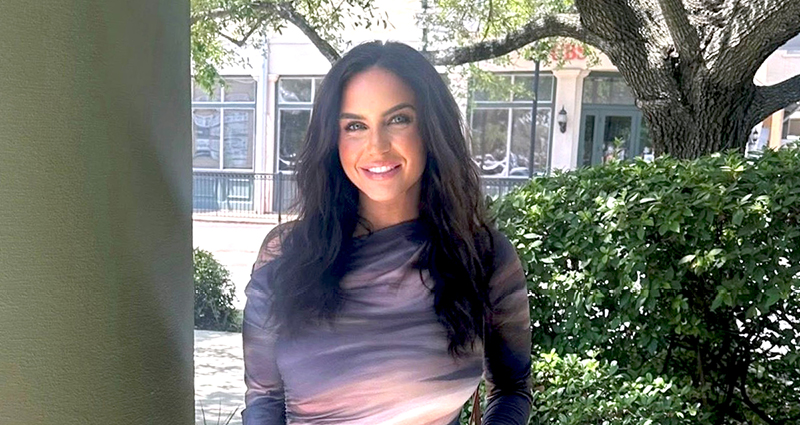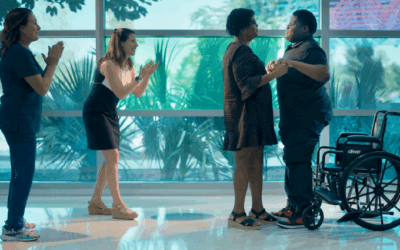Megan Claire McCarty always took pride in living a healthy lifestyle. She worked out three to five times per week for more than a decade. She ate clean and avoided alcohol and smoking. After the birth of her daughter, now 5, she was right back into her fitness routine and lost the additional weight within a month. Her only vice was caffeine – multiple energy drinks and cups of coffee were part of her daily routine.
So, at age 31 with no known health issues, it came as a complete shock last July when McCarty suddenly blacked out and felt out of sorts while visiting with a friend.
“I started to leave, and I felt really weird,” she recalled. “He asked if I was okay, and I told him I felt like I needed a nap. I’ve never been drugged, but the sensation I had is what I imagine being drugged would feel like.”
Recognizing the Signs: A Friend’s Quick Thinking
McCarty’s friend , who received medical training while serving in the military, immediately suspected she was having a stroke. He asked McCarty to raise her left arm, which she could not do. When he called 911, McCarty went into a panic.
“He tells me, ‘You are having a stroke.’ I told him I wasn’t. I was trying to grab the phone from him,” she said. “I told him I needed water. When I tried to drink water, I spilled it all over my shirt. That’s when I knew something bad was going on.”
Rapid Stroke Response
McCarty was brought to Our Lady of Lourdes, Acadiana’s first Stroke Center of Excellence. Doctors quickly confirmed the diagnosis and told McCarty she had the option of receiving a powerful medication called a tissue plasminogen activator (tPA), that would destroy the blood clot causing the stroke.
“We always say time is brain, because the brain is very sensitive. Studies show that 32,000 neurons die in one second when somebody is having a stroke. That means the brain is aging more than normal,” said Dr. Saad Karim, Our Lady of Lourdes vascular neurologist and stroke specialist. “That means that every minute a stroke patient doesn’t receive treatment, 1.9 million neurons are lost. And, once they are gone, they are gone forever.”
McCarty was initially apprehensive about taking the medication, with concerns about its effectiveness and possible side effects. The potential for long-term brain damage ultimately outweighed any fears, as did the advice from Dr. Karim. McCarty received the medication and dozed off. When she awoke about two hours later, she was nearly back to normal.
The Life-Saving Power of tPA
“My body was weak, but everything else was fine,” she said. “When I first saw my neurologist, they called me the miracle child because I have had no deficiencies. I later learned from Dr. Karim that if I had chosen not to have the tPA, that I probably would have been paralyzed or unable to talk because of where the clot was and how big it was.”
Our Lady of Lourdes is 1 of 3 hospitals in Louisiana and the only one in Acadiana to earn the American Stroke Association Get With The Guidelines® Stroke Gold Plus honor for 10 consecutive years, demonstrating the facility’s adherence to the latest research-based clinical guidelines that support better outcomes for stroke patients. Innovative treatments available include the tPA clot-busting injection and thrombectomy, a procedure used to remove larger clots and stop strokes in their tracks.
“We are able to do a lot of tests and calculations to see how much of the brain has died and how much more is at risk,” Dr. Karim explained. “In the past, a lot of doctors were more apprehensive about treating stroke patients because of a risk of bleeding. That has changed in the last four to five years based on a lot of new research. We are able to treat bigger strokes now because we’ve established the treatment is safer and the benefit to the patient’s brain is much higher.”
A Remarkable Recovery and a New Outlook
Although most strokes occur in people with a history of diabetes, high cholesterol, smoking, alcohol or drug abuse and a sedentary lifestyle, that was not the case for McCarty. She is still unsure exactly what caused her stroke, although she has stopped consuming energy drinks and some optional medications as she has become more mindful about what she puts in her body. During her stroke recovery, McCarty also discovered she has irregularity that causes her heart to beat too fast at times. She now sees a cardiologist for regular monitoring and has routine check-ups with a neurologist.
“I am staying in the gym, but my workouts are less intense now,” she said. “I still stay true to my diet, but if I really want the cheeseburger, I do eat it. I live my life a little more now. I’m much more conscious about what I put in my body. I walk a lot more and a drink more water than I ever did. I have more energy than I did before. The whole experience made me open my eyes to how I live my life and how I treat my body.”
Advancing Stroke Care Across Acadiana
Dr. Karim said younger stroke patients like McCarty often experience better outcomes because their brains are younger. However, several doctors and clinicians at Our Lady of Lourdes meet regularly to review all recent stroke cases, discuss the patient outcomes and collaborate on ways to help heal as many patients as possible.
“We have target goals on how quickly a stroke patient is evaluated in the emergency room, how quickly they have a CT scan, how quickly they see a neurologist and other steps in the patient journey,” Dr. Karim explained. “Every month, we sit down and discuss each case, including what went well and if there are any areas to improve. Our standing as a Stroke Center of Excellence means a lot to us, so we work hard to make sure we live up to that credential.”




